Description of garden plants and their use in the landscape

You always want to make your own plot beautiful and cozy. Garden plants are often used to decorate the landscape, with the help of which it is possible to create unique compositions that attract attention. It is worth considering in more detail which plants are suitable for landscaping.



Peculiarities
Garden plants are popular with landscape designers. With the help of various flowers and shrubs, several functions can be performed at once:
-
create a certain decor, set the atmosphere and mood for the decorated place;

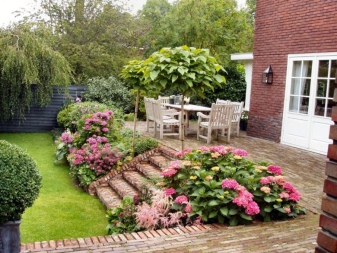
- make the garden comfortable by forming the necessary shade with the help of trees;

- to level the unevenness of the natural relief through the planting of certain compositions;


- protect the area from prying eyes or other people's pets.


Of course, we must not forget about the main function of plants - the production of oxygen. The more green spaces on the site, the fresher and cleaner the air will be.
Overview of flowers and herbs
Who would have thought that you can decorate the site using an ordinary lawn. At the same time, the choice of a suitable grass also needs to be approached responsibly, because manufacturers produce different types of lawn vegetation. Designers recommend giving preference to mixtures of drought-resistant grasses or bluegrass grasses.
And you can also land on the site:
-
fescue;

- ryegrass.

If you want to choose other plants for the garden, in addition to the lawn, you need to take into account not only the appearance of green spaces, but also the conditions for comfortable growing of new seedlings.
Consider the popular types of flowers and herbs that are often used to decorate the landscape.
-
Perennials. In this case, preference can be given to frost-resistant varieties of roses - this is a classic that can be found in almost every garden. For the growth of roses, you can install a special support or a stretched cord. And also perennials include peonies, which bloom in early summer, curly clematis and forget-me-nots.



- Unpretentious. A standard option for those who are not used to constantly looking after flowers and living outside the city. Such plants will grow in any conditions. This group should include marigolds, calendula, carnations, daisies, which love acidic soil.




- Forest flowers: lilies of the valley, woodlands, bells. It is recommended to grow such plants in shady areas, but they will be able to survive in sunny areas.

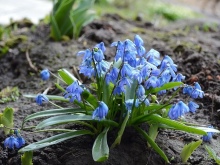

- Bulbous crops. They are included in the group of ornamental plants, but due to the large number of species they form their own subgroup. Lilies, daffodils, gladioli and crocuses will help to decorate the site.

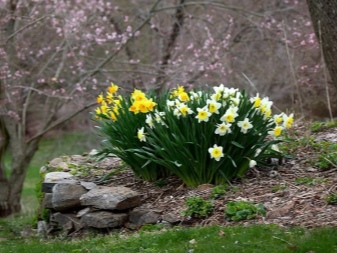


Plants can be planted in a flower bed or distributed along paths that wind through the site.
Attention should also be paid to exotic cultures that are rarely found in the local landscape.
-
Lobelia. The flowers of this plant are painted in a light blue color, the diameter of the growing ball reaches 25 cm, and flowering occurs from June to late autumn. It is recommended to plant light-loving lobelia in small pots. If conditions permit, you can place the seedlings in open ground.


- Pennisetum. A meter-long plant will be a decoration of the autumn garden. A feature of this unique culture is the small grassy hairs of a silvery or purple hue at the end of the stem. The plant does not require special care and watering.

- Liatris. An interesting flower shaped like a candle.Landscapers like their bright lavender flowers. It is worth planting in warm and fertile soil.


- Lupine. Another unusual flower with cone-shaped inflorescences, which can become a decoration of a suburban area and attract the attention of everyone who decides to take a walk in the garden. Lupine grows mainly in shaded areas, burns and dies under the bright sun.
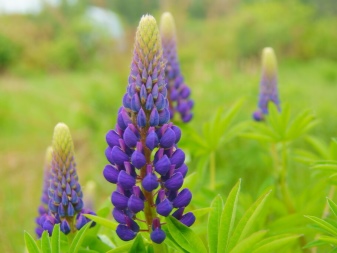

Not so long ago, creeping decorative pumpkins began to be used in landscape design projects. This plant can become a real substitute for flowers in the fall.
The culture should be planted in early May in loose fertile soil. The maximum diameter of a decorative pumpkin is 15 cm.


Variety of trees and shrubs
To create attractive landscapes, designers use different types of shrubs, trees and flowers, constructing various compositions from them. Thanks to the unique combinations of plants of different species, it is possible to revive even the most "gray" space of the site, to make it brighter and more comfortable.
Evergreen
The most popular group of plants in landscape design, the advantage of which is the beauty of the crown - they can delight others with it all the time. Evergreens include non-flowering conifers:
- thuja;
- pine trees;
- ate;
- cedars.
It is noteworthy that in some species, closer to winter, the crown becomes brighter and more expressive, acquiring a rich green hue. Spruces and pines are usually used to decorate large areas or large gardens.
It is recommended to plant these trees at a sufficient distance so that they do not interfere with the growth of each other and other plantings.

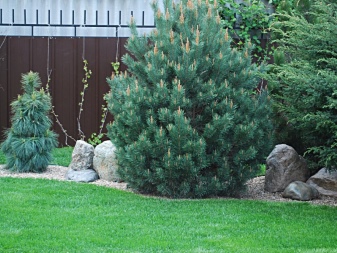
Yew is a pretty coniferous plant that thrives in shade. The maximum height of the tree reaches 3 meters, the needles of the species are dense, completely cover the plant, protecting it from frost.

Cedars are an even taller species of evergreen trees, reaching a height of 5 meters under favorable growing conditions. It is better to plant the breed in poor soils, where there is enough free space.

The best evergreens for medium to small gardens are hemlock or mountain pine.
Both trees are distinguished by their attractive appearance and expressive color of the needles.


Beautifully blooming
The garden can be decorated not only with green trees and shrubs, but also with ornamental plants with attractive and unique flowers.
-
Camellia. An ornamental shrub that prefers the sun. Camellia has rather large pink flowers. The leaves of the plant are glossy. Blooms mainly in autumn, but leaves last longer than flowers. A moisture-loving plant that needs careful care.
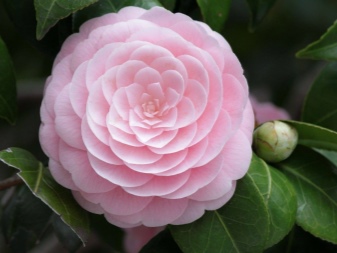

- Tamarisk. During flowering, the bush throws out a huge amount of small pink and white flowers. Small flowers, gathered in attractive inflorescences, will help to make the garden landscape more cozy and cute.


- Lilac. Popular landscape gardening shrub. In spring, white and lilac brushes with fragrant flowers appear on the branches of the plant. Lilac blooms for a long time, but only once a year.

You can also decorate a garden or a large house plot with other flowering crops. Designers will definitely select a suitable option that fits perfectly into the composition and helps to make the landscape attractive and cozy.
Decorative deciduous
Such bushes and trees have an expressive unique color, for which they attract the attention of landscape designers. Basically, ornamental plants are winter-hardy varieties of crops, among which several names can be distinguished.
-
White turf. A pretty garden bush with unusual leaves, the border of which is painted silver. The plant does not produce flowers, but it does not become less attractive. The shrub does not require special care, it quickly takes root.

- Winged euonymus. An unusual plant with expressive leaves, which change color to pink closer to the autumn season. In the spring, small inflorescences can be seen on the bush. The bush usually grows in shaded areas.


- Barberry. Most varieties of the plant have red leaves and delight others with bright berries that appear on the branches closer to autumn. Landscapers prefer to plant barberry bushes near evergreen crops or ornamental flowers.
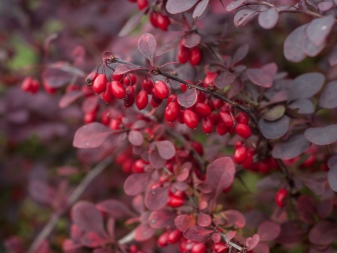

- Decorative maple. Often found in spacious gardens. The advantage of the plant is the ability to give its crown any shape. It is recommended to plant a tree in sunny areas; in winter, it is better to cover the maple with protective materials.


And also the garden can be decorated with holly, weigela and bubblegum. These are common crops that do not require special care and quickly take root in any conditions.
Other
Garden designs are varied and offer many design ideas. In addition to standard plants, you can also refine the area with fruiting dwarf pears or apple trees. Cultures such as:
-
honeysuckle;

- elder;

- viburnum.

The advantage of plants is that they will not only become a decoration of the garden, but will also benefit in the form of delicious fruits.
How to decorate a garden?
Landscape design requires a careful approach to the selection of plants and the composition of the compositions that will decorate the selected area. The compatibility of flower, evergreen and tree crops will give a high-quality result and help make the garden in the country cozy and comfortable to stay.
Here are some guidelines for decorating a country garden.
-
Trees and shrubs are best planted in predefined areas, and spreading plants along the fence is ideal. And also with the help of cultures, children's areas, recreation and sports areas are distinguished, which helps to improve air quality and at the same time achieve the necessary shade from the crown of trees.


- Shade-tolerant crops should be planted in the northeastern or northwestern part of the site. The main decorative elements of the landscape are allocated a place on the front side of the house.


- When forming flower beds or organizing vertical gardening, it is necessary to ensure that the plants do not stop blooming during the summer. Therefore, in flower beds or on boles, it is recommended to plant both primroses and flowers that give flowers later.


- The beauty of green vegetation can be accentuated by green lawns. For this, different types of lawns are suitable.


- Arches and gazebos can also be decorated with plants. For example, grapes that grow every season, as well as climbing roses, will look good.


- A piece of land designed to look like a natural landscape will help to create a corner of a real forest. In this case, it will be necessary to include in the design project alpine slides, trees and shrubs that are found in the forest.


When forming any composition, it is important to preserve the sense of proportion, style and entourage of the future landscape.
In the process of developing a design, you need to choose the style of the future garden, which will subsequently help organize an effective selection of the necessary plants and decor. For example, the Baroque style is characterized by an abundance of floral arrangements. Perennials in combination with annual seasonal flowers that will make the landscape bright will help here.
Any style can be supplemented with attributes - small details, with the help of which it will be possible to emphasize the features of the landscape and place the necessary accents.


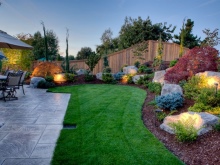







































































































The comment was sent successfully.